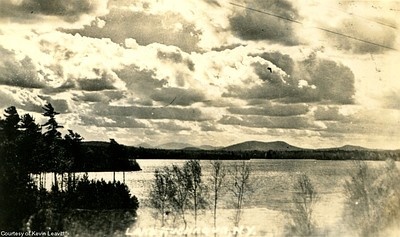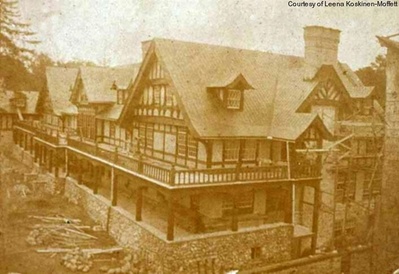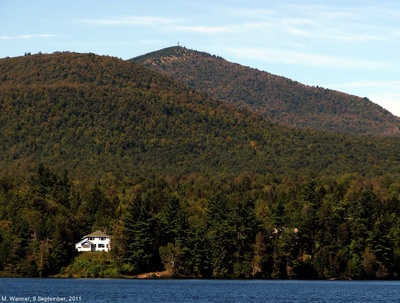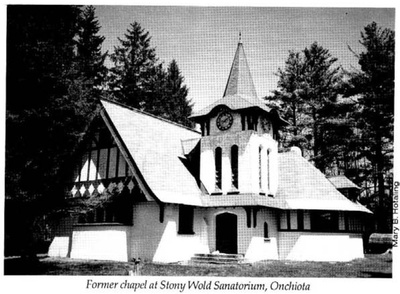 Post Card, Lake Kushaqua, August 22, 1946
Post Card, Lake Kushaqua, August 22, 1946  Lake Kushaqua
Lake Kushaqua  Stony Wold Sanatorium, newly completed, c. 1901-04
Stony Wold Sanatorium, newly completed, c. 1901-04  The other cottage on the lake
The other cottage on the lake  One of the two inholdings on Lake Kushaqua, with Loon Lake Mountain (?) and its fire tower, behind. The second cottage is just visible through the trees at right. The Stony Wold chapel is 800 feet to the left of the white cottage.
One of the two inholdings on Lake Kushaqua, with Loon Lake Mountain (?) and its fire tower, behind. The second cottage is just visible through the trees at right. The Stony Wold chapel is 800 feet to the left of the white cottage.
 Detail of the cottage above, taken 18 years earlier, from the opposite side of the house. Lake Kushaqua is a 375-acre lake near Loon Lake and Rainbow Lake in the town of Franklin; it is on the North Branch of the Saranac River. The north end of Lake Kushaqua flows under a metal deck bridge on Kushaqua-Mud Pond Road and exits over the Lake Kushaqua dam, morphing back into the North Branch of the Saranac River and flowing toward Mud Pond and beyond. The dam is owned by the Rainbow Lake Water Protection District. In 2018 the 14-foot high dam was raised 2.5 to 3.5 feet to better prepare it to withstand a 100-year flood.
Detail of the cottage above, taken 18 years earlier, from the opposite side of the house. Lake Kushaqua is a 375-acre lake near Loon Lake and Rainbow Lake in the town of Franklin; it is on the North Branch of the Saranac River. The north end of Lake Kushaqua flows under a metal deck bridge on Kushaqua-Mud Pond Road and exits over the Lake Kushaqua dam, morphing back into the North Branch of the Saranac River and flowing toward Mud Pond and beyond. The dam is owned by the Rainbow Lake Water Protection District. In 2018 the 14-foot high dam was raised 2.5 to 3.5 feet to better prepare it to withstand a 100-year flood.
The shoreline is state owned except for two small in-holdings.
The New York State Department of Environmental Conservation operates a campground on Kushaqua and nearby Buck Pond.
The pond was originally called Round Pond; the name seems to have changed when the Lake Kushaqua Hotel was built, in 1893, by Arthur Leonard and Frank Smith, one of the first hotels in the Adirondacks with electric lighting. It was accessible via the Chateaugay Railroad and the Adirondack Division of the New York Central Railroad, which passed the lake on either side. The developers were associates of railroading brothers W. Seward Webb and H. Walter Webb.
In 1901, the Stony Wold Sanatorium was built on 1800 acres bordering the lake.
The rail bed of the Delaware and Hudson line runs along the eastern shore of the lake, past the Buck Pond campground, and that of the Adirondack Division of the New York Central Railroad runs along the western shore past the remaining buildings of Stony Wold: the beautiful chapel and two cottages on the lake shore. When it was built, the 1200-acre sanatorium property included all of Lake Kushaqua and nearby Buck Pond, purchased in 1901 for $20,000. When the sanatorium closed in the 1950s, it was given to the White Fathers of Africa; they sold it to the state in 1970, after which the huge main building, laundry and power plant were destroyed.
It was the site of Pine Park Camp, built in 1916.
AARCH Newsletter, May 1995, vol. 4, no. 1 (pdf, page 11)
New Issue: "Time Bombs"
 When the state purchased the Santanoni Preserve, it took over 20 years to resolve the dilemma of what to do with the significant buildings on the property. NYS's Historic Preservation Act requires that determination be made of the historical and architectural significance of any property the state plans to acquire. If OPRHP declares it eligible for the State Register of Historic Places, then Environmental Conservation Law Section 9-0109 all but prohibits state purchase.
When the state purchased the Santanoni Preserve, it took over 20 years to resolve the dilemma of what to do with the significant buildings on the property. NYS's Historic Preservation Act requires that determination be made of the historical and architectural significance of any property the state plans to acquire. If OPRHP declares it eligible for the State Register of Historic Places, then Environmental Conservation Law Section 9-0109 all but prohibits state purchase.
While the problem of Santanoni is being successfully resolved, and AARCH has been working to prevent the same problem from recurring when the state makes new land purchases, there are certain other buildings within the Forest Preserve which seem not to have been evaluated for historic or architectural significance at the time the properties were acquired. Some of these buildings have been leased to others by DEC for a term of years, or the previous owner may have retained an interest. At the end of the term of these agreements, the buildings, some of which we believe to be eligible for the State and National Registers, are scheduled to be demolished. These situations usually only come to public attention at the time the leases are up, as happened with the last camp on Valcour Island in the fall of 1991. We call these "time bombs."
AARCH is aware of several buildings in this situation. The chapel and some cottages at the former Stony Wold Sanatorium (later called the White Fathers and later still Camp Lavigerie) on Lake Kushaqua in the Town of Franklin, Franklin County, have only about four years before their leases are up. Debar Park Lodge in the Town of Duane, Franklin County, has about 12 years. There may be more. The time to evaluate these buildings for their significance is long before the leases are up. We ask the help of AARCH members and friends to let us know of similar situations with other potentially historic buildings in the Forest Preserve.
Plattsburgh Sentinel, June 17, 1904
Walter Hooey completed a pulp wood drive, consisting of about 7,000 cords, on Saturday, for the International Paper Co. The drive started from Lake Kushaqua about a month ago.
Adirondack Daily Enterprise, February 15, 1984
Dam sale plan sparks dispute
By CHARLES DECKER
ONCHIOTA - Saranac Lake isn't the only place in the North Country struggling to resolve ownership of an aging dam.
A similar situation has developed in the Town of Franklin where the New York State Gas and Electric Co. (NYSEG) is trying to unload a small impoundment it owns on the North Branch of the Saranac River at the outlet of Lake Kushaqua.
Known as the Kushaqua Dam, the approximately 50-year-old structure controls the water level for most of the 25-mile water network in the Onchiota area, including Rainbow Lake and Buck Pond.
NYSEG built the existing twin-spillway facility in the 1930s after acquiring the site from International Paper Co.. which operated the first dam there which was built shortly after the turn of the century.
The dam essentially has been unused since the 1940's. except for NYSEG's routine maintenance and periodic adjustments in the water level to protect shoreowners' property.
The utility now wants to sell the dam because, officials claim, it is strictly a liability they no longer can afford. Saying it serves no useful purpose and the taxes are too high. NYSEG wants to pedal the structure and relieve itself of the responsibility of ownership.
Recently, NYSEG asked the Town of Franklin to look into reducing the assessment on the dam to lower the taxes and make it more attractive to a potential buyer.
In a November letter to the Franklin Town Board, NYSEG calculated the current value of the dam at $13,612.46, or almost 10 times less than the town's valuation. Based on that value, the utility says annual property taxes should be about $371, well below the present levy of approximately $3,400. The total tax bill on the dam, including the and school levy, is estimated at $5,000.
"Thirty-four hundred dollars a year in property taxes is just ridiculous," insisted one NYSEG official familiar with the.situation. "We can't afford to pay that kind of money for a facility that serves no useful purpose to our stockholders whatsoever."
However, NYSEG knows that for at least three different parties, the dam has substantial value. Shoreowners whose property is affected by water levels, the state Department of Environmental Conservation which operates a campsite on Buck Pond, and the townships of Franklin and Brighton whose finances are based on the value of the properties they contain, all have vested interests in keeping, the.dam intact..
NYSEG insists its sole interest is to sell the dam, but has.reminded the various parties of its right to breach it if no suitable transaction is reached within a reasonable amount of time. However, even NYSEG officials admit the hollow nature of any threat that the dam would be breached. "To exercise that right would be an immoral act," said one source with the utility.
Instead, the utility is involved in negotiations to-sell the dam.to the Rainbow Lake Association (RLA), which represents the Rainbow Lake shoreowners whose property lies downstream from the impoundment.
NYSEG originally anticipated a swift transaction with the RLA based upon a 25-year agreement signed between the two in 1948 which set forth conditions for the possible sale of the dam. According to the pact, the RLA would have first option to buy the dam at a price established by a depreciation formula set forth in the agreement.
Although the agreement expired in 1964, NYSEG officials say they still expected to honor its terms and approached the RLA last year to inform the association of the plans to sell. The quick sale NYSEG hoped for never materialized; in part because of the tax situation and price haggling, but perhaps more because of a standoff which developed between utility officials and the president of the RLA, Charles Meisenheimer, a summer resident from New Fane.
According to a NYSEG source, the utility wrote Meisenheimer and asked him to make an offer for the dam on behalf of the RLA. The response NYSEG received was unsatisfactory, although the source declined to reveal specific figures.
The source said Meisenheimer's offer amounted to "Why don't you give it to us for a song since it's of no value to you," but the utility balked because of the problems of longterm liability for the structure.
"Say we deeded it over to the RLA for a dollar, and then down the road sometime some serious problem developed. What's to prevent them from making a case against us along the lines of the big bad company shoved the problem off on us for a buck just to avoid future responsibility?" asked the NYSEG source.
NYSEG says a transaction with the RLA is.still a strong possibility, and the attorney handling the case for the association, Matthew Dwyer of Lake Placid, today expressed optimism that an agreemelf will be reached.
"Negotiations from our point of view are ongoing and we hope that, they will be fruitful," Dwyer said.
But in the meantime, the possibility of competition in the marketplace has arisen with the recent interest in the sale by the Franklin Town Board. Town Supervisor Mary Ellen Keith said because the dam is vital to the value of property in the towns of Franklin and Brighton, the board is investigating the idea of creating a tax-supported water control board or "dam district" to assume ownership of the dam, possibly in conjunction with the Town of Brighton.
"I think we owe it to our people and our town to make sure that we don't let something happen that would in any way threaten our property values. Our tax base out here is already so thin." she said.
Keith said the board has directed Town Assessor John Ryan to investigate the financial implications of a town takeover. "We haven't made any decisions," she stressed. "We've got to explore all possibilities." The DEC says it has no interest in owning the dam, but is monitoring the situation closely because of the implications for Buck Pond Campsite.
Comments
2012-05-06 09:51:56 Great Shot My family and I rent the "Roads End" cottage every year. A slice of heaven on earth! —168.244.164.220



